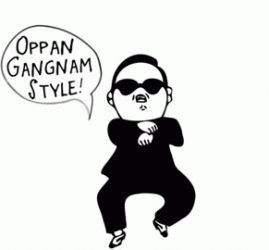In the music video “LOVE” featuring TAEYANG, Psy tries to normalize the idea of individualism by writing lyrics relatable to the fans, while emphasizing the importance of caring and accepting. Due to his previous work in K-pop like “Gangnam Style”, Psy’s reputation as a comedic relief is undeniable and it has become difficult for fans to treat him seriously. This music video perfectly contradicts the notion of humor and shifts our attention towards empowerment and change, especially in a modern society where pessimism and hate are common. “LOVE” provides an alternative perspective of the artist where he has taken an active role in addressing social issues such as inequality and challenges the social traditions of marketing and producing K-pop music videos.
Hallyu began when Korean popular culture was exported internationally with the help of social media. According to Jung, social media such as YouTube is an internet-based application designed to facilitate the interaction of user-generated content on a transnational scale (2015, 73-76). Throughout the music video, a cast of female choreographers performed in front of a white background and Psy never appeared once in the video. Comparing to Psy’s other music videos, the rareness of not participating in the filming process and changing the focus to women shows an unexpected side of marketing. In addition, an English version of the lyrics and set choreography targeted an international audience who can easily learn the choreography, recreate it with a cover video, and organize flash mobs using user-generated social networking platforms (Jung 2015, 81-82). Psy as a producer enhanced the relationship with fandom by being inconsistent with the previous production process, as a result, fans would consume and react with either appreciation or dissatisfaction. It essentially created a reciprocal relationship between Psy and his fans, both the artist and the consumers “successfully transform themselves into equally important players in the global game of social networking” with the utilization of popular social media platforms (Jung 2015, 85).
Although the main attraction of the music video was the choreography, none of the dancers were portrayed as sexual objects that served the sexual pleasure of the viewer. Apart from the red short skirts which could elicit sexual behaviors and objectification, the fashion decision behind each dancer was considered conservative. In contrast to the sexual objectifying cases mentioned by Kistler and Moon, Psy’s music video didn’t “promote distorted sexual norms” that were dehumanizing towards women and there weren’t any signs of sexual coercion that would perpetuate traditional gender attitude (2009, 82). In fact, the choreography in “LOVE” demonstrated signs of empowerment with their powerful and up-beating dance routine. The strength of women in this music video certainly contradicts with the production style of mainstream K-pop, which depicts female as the lesser gender of two and the existence of women is “for the entertainment and sexual fulfillment of men” (Kistler & Moon 2009, 83).
Due to the absence of Psy in “LOVE”, these foreign dancing bodies were the main characters of the music video as it was aligned with and the overarching message of the song which was uniting one another through caring, especially post-conflict and solidarity. They weren’t used as commodities for male viewership and it was different than Saeji’s description of using foreign bodies as “the object of the sexual desire or love of a Korean star” (2016, 280). Psy’s innovative ideas with foreign bodies challenge the social tradition of music production. By placing them in the forefront of the video and lowering the level of sexuality of the foreign dancers, “LOVE” has the potential to lure more International followers while losing K-pop fans who are hungry for authenticity. He created an alternative way of utilizing foreign bodies.
“LOVE” provided fans a matured Psy who was different in the previous music video, the message of empowering women and low levels of sexuality from foreign bodies challenges the social norm of making K-pop music videos
Reference
Jung, Eun-Young. “K-Pop Idols, Social Media, and the Remaking of the Korean Wave.” Edited by Sangjoon Lee and Abé Markus Nornes. Hallyu 2.0: The Korean Wave in the Age of Social Media, (2015): 72-89
Kistler, Michelle E., and Moon J. Lee. “Does Exposure to Sexual Hip-Hop Music Videos Influence the Sexual Attitudes of College Students?” Mass Communication and Society 13, no. 1 (December 22, 2009): 67-86.
Officialpsy. “LOVE (feat.TAEYANG).” YouTube. July 16, 2017. Accessed December 07, 2018. https://www.youtube.com/watch?v=K5ve5lzs0wM.
Saeji, CedarBough T. “Cosmopolitan Strivings and Racialisation: The Foreign Dancing Body in Korean Popular Music Videos” Korean Screen Cultures: Interrogating Cinema, TV, Music and Online Games (New York: Peter Lang, 2016)

